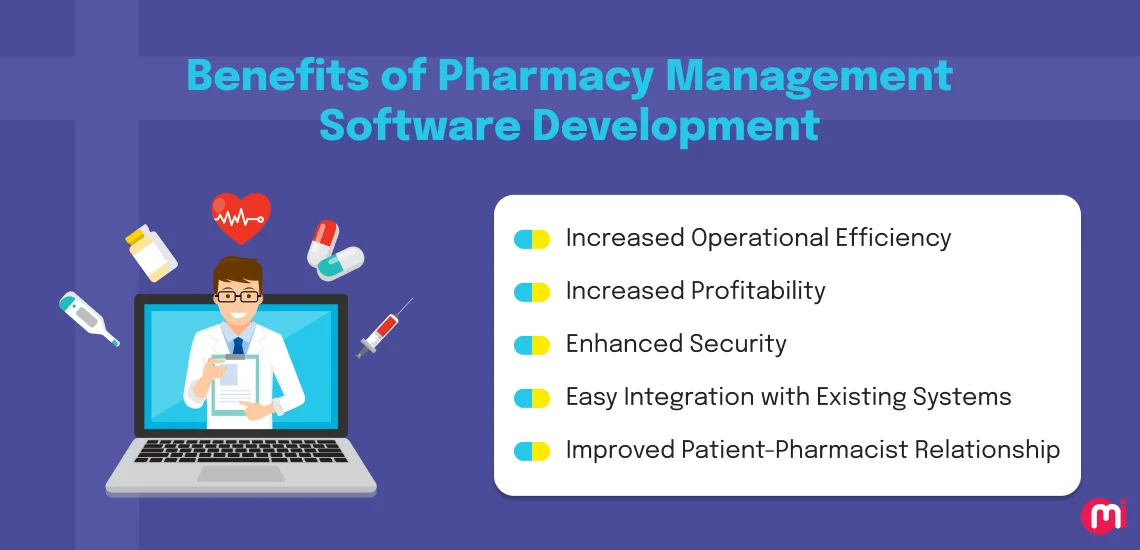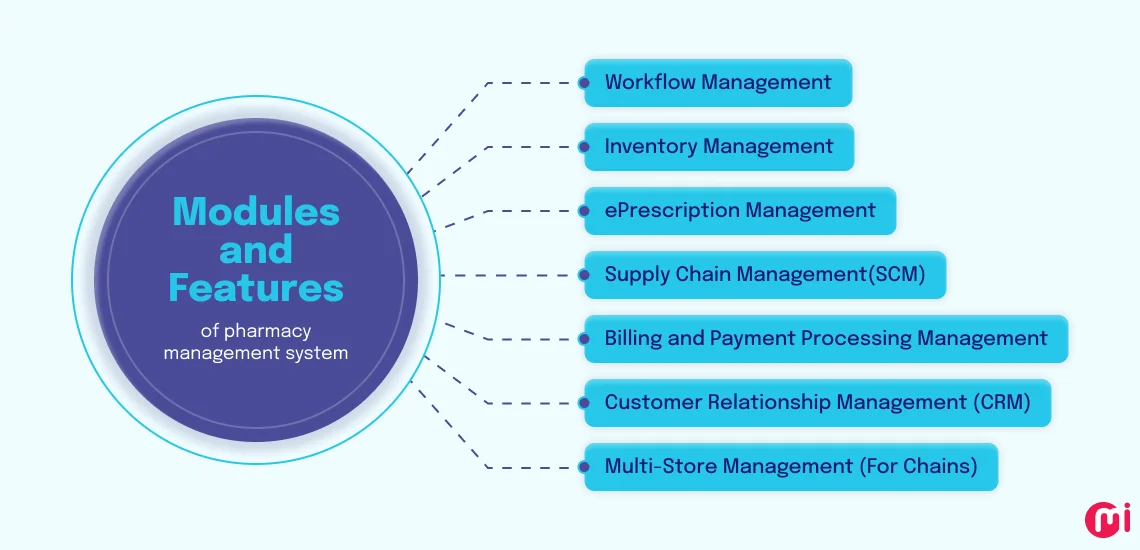Considering Pharmacy Management Software(PMS) development and wondering which features and modules you should include? This blog lists the essential components of PMS, including key modules and features. You will also discover the benefits of investing in a PMS and a breakdown of the development costs associated with it.
If day-to-day operations at the pharmacy look like this:
- Struggling to keep track of inventory
- Manual prescription handling errors now and then
- Haunted by compliance nightmares
- Lack of real-time insights into sales trends, employee performance, etc.
- Disorganized supply chain
- Billing inaccuracies affecting customer satisfaction
- Increasing operational overhead without improving outcomes
It’s time to invest in pharmacy management software development!
These operational hiccups can be addressed with various modules and features of a custom PMS.
Before we explore those modules and features, let’s first discuss some of the benefits of investing in a PMS for your pharmacy business.


Benefits of Pharmacy Management Software Development
Rather than just a technical upgrade, Pharmacy Management Software (PMS) is a strategic investment that drives your business toward greater operational efficiency, regulatory compliance, and enhanced collaboration. By streamlining workflows and optimizing operational costs, PMS provides significant ROI while boosting your business’s reputation.
Whether you operate a single pharmacy or manage a large chain, here are the benefits of investing in custom pharmacy software development:


Increased Operational Efficiency
Pharmacy operations involve much more than just dispensing the right medications. A lot goes on than meets the eye. From automating routine manual tasks like inventory tracking to providing a unified view of the business, PMS offers significant improvements in efficiency and productivity.
Tasks that were once fragmented across various systems or locations are now integrated into a single, streamlined platform. This reduces human error, minimizes delays, improves oversight, and speeds up customer service, contributing to a smoother and faster operation.
Enhanced Security
Given the amount of patient data that these pharmacies have, these systems are often prone to cyber threats. However, having a comprehensive PMS deployed on the cloud provides an extra layer of security to the software along with the security measures implemented by the software developers.
Increased Profitability
PMS results in better utilization of resources, reduced labor inefficiencies, optimized inventory management, and more, eliminating the possibilities that lead to costly mistakes.
Furthermore, it offers actionable data insights that help pharmacy owners make informed decisions about pricing, inventory procurement, and customer preferences. This data-driven approach not only boosts sales but also helps identify opportunities for cost-saving measures, leading to improved profit margins.
Improved Patient-Pharmacist Relationship
Offering personalized customer journeys to patients makes them feel understood on a personal level. A PMS makes this happen by providing easy access to up-to-date information about millions of patients. With it, you can offer personalized engagement backed by accurate data and their history, enhancing their experience and boosting their loyalty.
Easy Integration with Existing Systems
Whether it’s electronic health records (EHR), Point of Sale (POS), insurance platforms, financial tools, or any other existing systems—including your current IT infrastructure—PMS integration can enhance overall functionality. This ensures that your pharmacy can continue to operate smoothly without disruption.
Market Scenario of Pharmacy Management Software
Currently, the market size of the Pharmacy Management System is valued at USD 87.53 billion. This market is expected to grow at a CAGR of 15.47% and reach USD 179.67 billion by 2029 during the forecast period of 2025 to 2029.
The same report highlights that the number of drug stores and pharmacies operating in the USA alone was recorded at 30,739 in 2023, which marks a substantial increase from 27,848 recorded in 2022. This rising number of pharmacies is anticipated to drive the increasing demand for PMS to automate tasks like inventory management, workflow management, and more.
With the rise of AI in healthcare, the pharmacy automation market is projected to grow at a CAGR of 7.6%, reaching $7.87 billion during the forecast period of 2024–2030.Similarly, the increasing adoption of EHR solutions is driving the ePrescribing market, which is expected to grow to $3.3 billion by 2025, exhibiting a CAGR of 23.3%. A PMS with ePrescription integration can enhance operational efficiency, allowing pharmacies to benefit from the growth in ePrescription adoption.
Modules and Features of a Pharmacy Management System
A well-developed PMS should be more than just a tool to manage prescriptions—it should serve as a comprehensive solution that improves operational efficiency, reduces costs, and drives better business outcomes. When investing in Pharmacy Management Software (PMS), it is essential to understand the core modules and features that will directly benefit your business.
Here are the key modules and essential features that every PMS should include:


1. Workflow Management
Being the heart of pharmacy operations, having a module that helps you automate most of the tasks while providing features that optimize the rest is a must in PMS. It enables a seamless and consistent flow of operations to enhance productivity and minimize errors.
Features to include in workflow management:
- Employee and staff management workflow
- Onboarding and offboarding of employees
- Task assignment
- Shift assignment
- Employee performance tracking
- Attendance tracking
- Staff training
- Workflow automation
- Task automation
- Alerts and reminders
- Approval and escalation workflows
- AI-powered decision support
- Inventory management workflow
- Stock replenishment
- Inventory audits
- Stock transfers
- Expiry date tracking
- Batch tracking
- Compliance and Regulatory workflow
- Regulatory document management
- Compliance audit trail
- License tracking
- Vendor and supplier management workflow
- Vendor orders and deliveries
- Supplier evaluation
- Quotation and PO management
- Procurement management
- Prescription management workflow
- Prescription intake
- Prescription validation
- Approval process
- Refill management
- Prescription dispensing
2. Inventory Management
From cost control and product availability to customer satisfaction, inventory management impacts it all. Managing inventory manually can result in stockouts, overstocking, wasted resources, and lost revenue.
A robust Inventory Management module within your PMS helps pharmacies to efficiently track, manage, and optimize stock levels, ensuring timely replenishment, reducing waste, and improving overall operational efficiency.
Features to include in inventory management:
- Real-time stock level tracking with cloud and IoT integration
- Automated stock replenishment
- Multi-location inventory management
- AI-powered demand forecasting
- Advanced analytics and big data integration
- AI-driven expiry date alerts
- Smart contracts for automatic inventory reordering
- Notifications on stock levels
- Barcode and RFID integration
- Custom auditing and reporting
3. ePrescription Management
As we have already seen the surge in the adoption of e-prescriptions in the market overview, with this surge comes the requirement to streamline the way prescriptions are issued, processed, and tracked. Along with enhancing efficiency, accuracy, and compliance, this module helps ensure seamless communication between healthcare providers, pharmacists, and patients.
Features to include in e-prescription management:
- E-prescription creation and management
- AI copilots for prescription optimization and medicine personalization
- Customizable prescription templates
- Real-time prescription validation
- Drug interaction alerts
- Integration with EHR
- Automated prescription refill reminders
- Secure prescription transmission to pharmacies
- Regulatory compliance management
- Patient notification and updates
- Cloud storage and role-based access control for enhanced security
4. Supply Chain Management (SCM)
The core of any pharmacy operation is ensuring that the right medications are available at the right time, in the right quantities, and at optimal costs. This is where the Supply Chain Management (SCM) module plays a critical role. It enables your team to oversee procurement, inventory management, distribution, and vendor coordination processes.
This module enhances supply chain visibility, aids in risk mitigation, improves inventory accuracy, and more.
Features to include in supply chain management:
- Real-time inventory tracking with IoT integration
- Real-time supply chain visibility
- Order management system (OMS)
- Purchase Order (PO) creation
- PO tracking
- Backorder/return management
- Bulk order management
- Shipping management
- Payment and Invoice management
- Refund management
- Procurement management
- Vendor management
- Quotation management
- Invoice management
- Supplier management
- Supplier information management
- Supplier relationship management
- Contract management
- AI-powered supplier selection and risk assessment
- Logistics management
- Fleet management
- Proof of delivery tracking
- Analytics and reporting (for procurement, supplier, warehouse, and order)
- Integration with Inventory, Enterprise Resource Planning (ERP), Customer Relationship Management(CRM), and other business systems
- Chatbots and virtual assistants
5. Billing and Payment Processing Management
One of the most complex aspects of pharmacy operations is the billing and payment process. It involves managing insurance claims and reimbursements, co-pay calculations, compliance, and handling payments securely. Which is when this module comes in during pharmacy software development. This module not only speeds up transaction processing but also reduces the administrative burden on staff while minimizing errors.
Key features to include in billing and payment processing management:
- Billing and Invoicing
- Automated invoice generation
- Invoice customization
- Invoice tracking & payment status
- AI-bases tax calculation
- Payment processing
- Integration with third-party payment APIs
- Multiple payment method support
- AI-powered fraud detection and transaction monitoring
- Insurance billing and claims management
- Automated insurance claim submission and processing
- Claims tracking & status updates
- Insurance underwriting automation
- Automatic copayment and deductible calculations
- AI claims verification or third-party integration of medical insurance verification software.
- Refund and return management
- Customer payment plans and financing management
- Real-time communication features and AI virtual assistants
- Integration with POS system, ERP, CRM, etc
- Advanced sales analytics and revenue forecasting
- Financial and compliance reporting
6. Customer Relationship Management (CRM)
Customer loyalty plays a crucial role in the growth and profitability of the pharmacy business. For customers, pharmacies are not just service providers; they are healthcare partners. Customers expect personalized experiences, timely service, and proactive communication. This can be addressed by including CRM during pharmacy management software development startegy.
A CRM module allows pharmacies to track customer interactions, preferences, and medication history, enabling them to deliver tailored services that go beyond mere transaction-based interactions.
Features to include in Customer Relationship Management:
- Customer profile management
- Medication and prescription history tracking
- Notifications and alerts
- Loyalty programs and rewards program management
- Analytics and reporting for customer trends
7. Multi-Store Management (For Chains)
For pharmacy chains, ensuring consistency across all stores while optimizing operations, inventory, compliance, and customer experience is critical for sustainable growth. This is where the Multi-Store Management module comes in. It is designed to centralize and streamline the management of multiple pharmacy locations, enabling business owners and managers to oversee and control various aspects of pharmacy operations across different branches from a single, integrated platform.
Features to include in multi-store management:
- Centralized administration management
- Dashboard for omnichannel visibility
- Role-based authentication
- Branch performance monitoring
- User/Employee management
- Cross-location task assignment
- Sales and order management
- Inventory management across stores
- New branch onboarding
- Financial management
- Workflow and task management
- Procurement and supplier management
- Integration with inventory, POS systems, ERP, CRM, etc
- Analytics and reporting(branch-wise, chain-wise, real-time, customizable)
Note: Depending on the type of pharmacy (independent, chain, retail, hospital, long-term care (LTC), veterinary, compounding, and more), the modules and third-party software or API integrations may vary. Apart from that, these are just some of the essential features that would help you to overcome most of your operational challenges.
Opting for custom software development services over buying pre-built solutions is recommended to ensure features are perfectly aligned with your operational requirements.
Cost of Pharmacy Management Software Development
The cost of developing pharmacy management software typically ranges from $30,000 to $500,000+ depending on various factors. The factors that affect the cost of pharmacy software development include:
- Complexity and customization of modules, features, and functionalities
- Integration of advanced technologies like AI, ML, RPA, etc.
- Choice of the technology stack
- Third-party integrations
- Complexity of software UI/UX design
- Data migration and cloud hosting requirements
- Post-deployment maintenance and support
- Compliance and security requirements
- Choice of getting the software developed in-house or outsourcing
If you plan to hire a software developer or a team from a custom software development company, factors such as the developer’s geographic location, experience, and engagement model will also influence the cost of pharmacy software development.
Unlock Operational Excellence with MindInventory’s Pharmacy Software Solutions
Your pharmacy deserves software that works as hard as you/your employees/executives do, and we can make that happen for you!
We are a leading healthcare software development company with expertise spanning various industries, including healthcare and wellness. Our software developers have hands-on experience with next-gen technologies, such as AI, demonstrated in one of our recent projects—a co-pilot for doctors that provided AI assistance during online consultations with patients.
Our team is proficient in a range of technologies that empower us to create dynamic, high-performing PMS systems:
- Frontend Development: React, Angular, Vue.js, TailwindCSS, JavaScript, and TypeScript
- Backend Development: Node.js, Python, Express.js, Go, and PHP
- AI & ML Tech Stack: ML-Agents, ChatBot, TensorFlow, DialogFlow, PyTorch, Scikit-learn, Microsoft Azure ML Studio, and IBM Watson Studio
- Database Expertise: MySQL, MongoDB, PostgreSQL, Firebase, SQLite, Microsoft SQL Server, Amazon RDS
These technologies, along with awareness of the latest software development trends, enable us to develop robust, intuitive, and scalable Pharmacy Management Systems that cater to your business’s operational needs.
Beyond pharmacy, we offer a wide range of digital solutions for pharmaceutical companies and the broader healthcare sector. Our expertise extends to developing Regulatory Compliance Software, Supply Chain Management Solutions, Clinical Data Management Systems, Finance and Billing Software, Laboratory Information Management Systems (LIMS), Data Analytics and Visualization platforms, and custom digital solutions.
Whether you’re looking to optimize your internal processes, enhance patient care with innovative solutions, or need to hire software developers to begin developing your custom PMS solution, we have you covered. Reach out to us to discuss how we can customize PMS or other digital solutions for your business.
FAQ on Pharmacy Management Software Development
When developing pharmacy management software, it’s crucial to adhere to industry-specific regulations to ensure compliance and data security. The key regulations include HIPAA (Health Insurance Portability and Accountability Act) in the U.S., which mandates the protection of patient data, and GDPR (General Data Protection Regulation) for European users, ensuring data privacy.
Implementing PMS can present several challenges. These include data migration from legacy systems, which may be complex and time-consuming. Integration with existing software, such as EHR or billing systems, can also be tricky and require careful planning. Training staff to use the new system effectively is another hurdle, as it demands time and resources. Additionally, ensuring compliance with industry regulations and security standards, like HIPAA, can increase complexity. Lastly, adapting the software to meet specific pharmacy workflows while ensuring scalability and user-friendliness can require ongoing adjustments and fine-tuning.













Leave a Reply